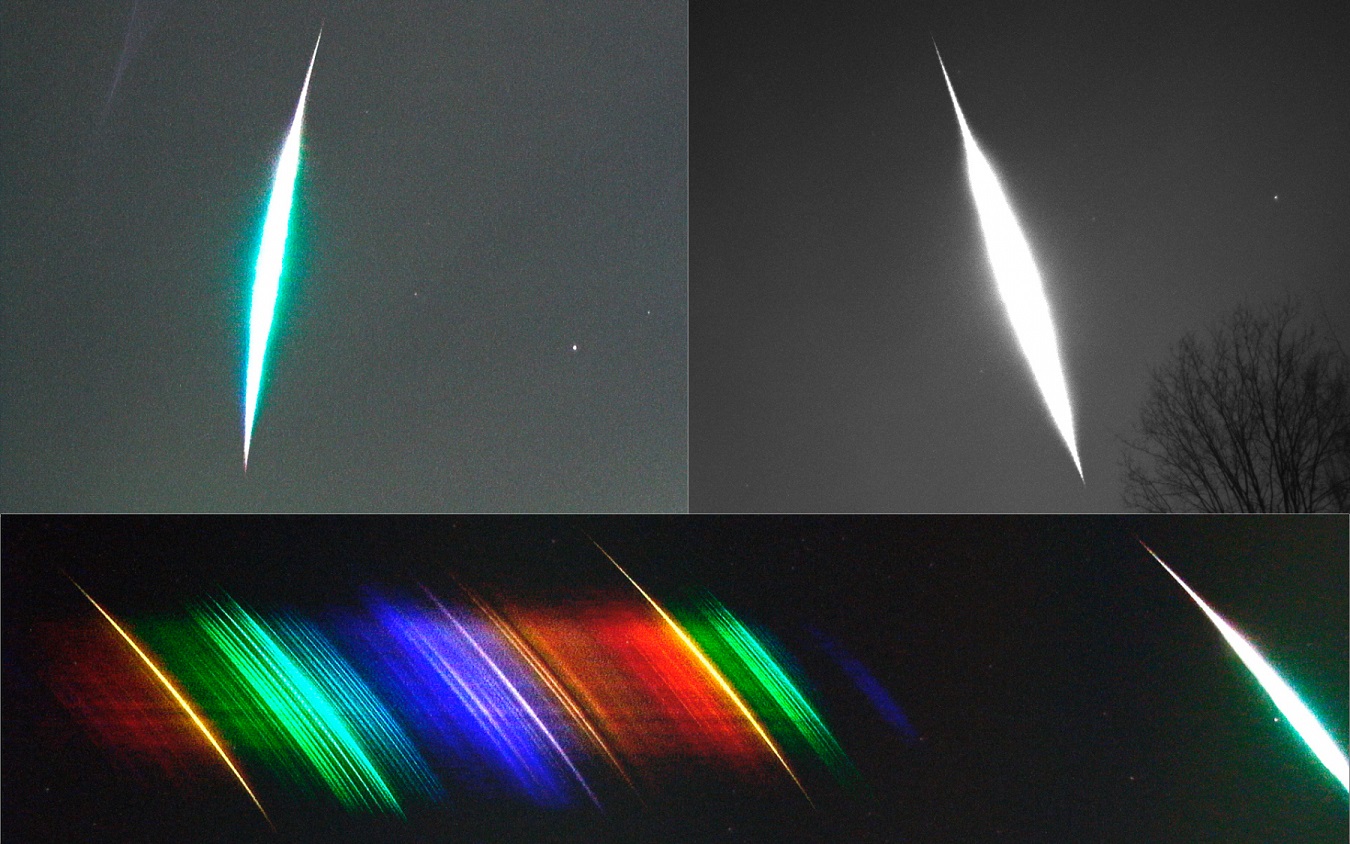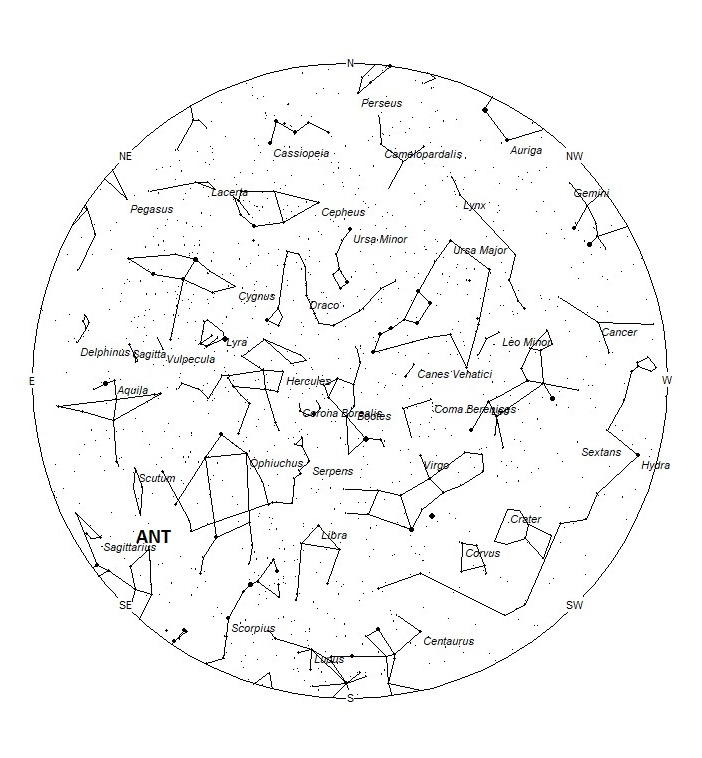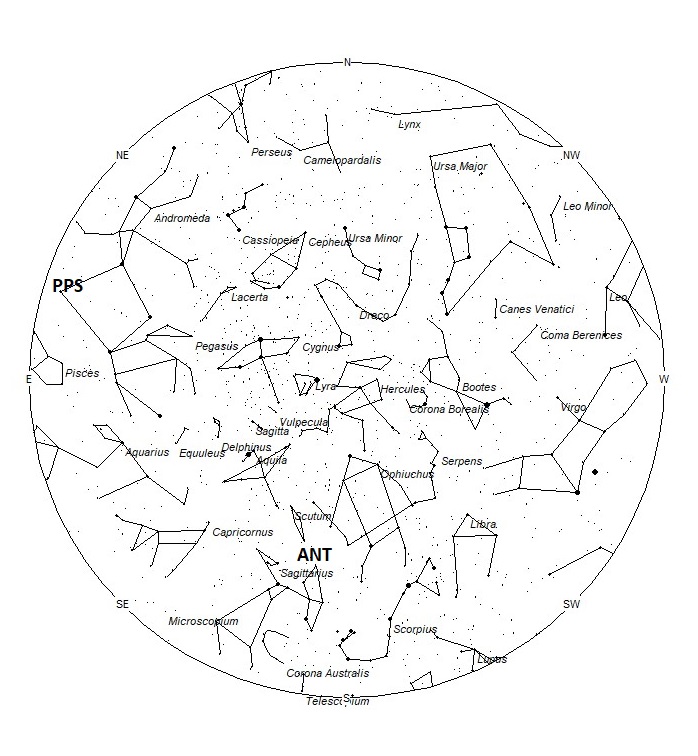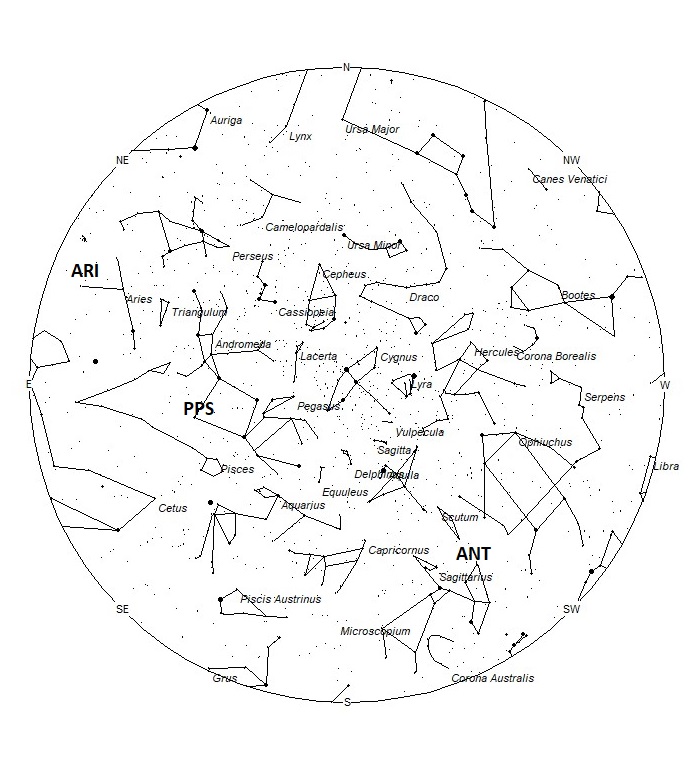
During this period, the moon waxes from half-illuminated to nearly full. This weekend the waxing gibbous moon will set during the early morning hours, allowing a small window of opportunity to view between moon set and dawn. The estimated total hourly rates for evening observers this weekend should be near 2 as seen from mid-northern latitudes (45N) and 3 as seen from tropical southern locations (25S) For morning observers, the estimated total hourly rates should be near 7 as seen from mid-northern latitudes (45N) and 11 as seen from tropical southern locations (25S). The actual rates seen will also depend on factors such as personal light and motion perception, local weather conditions, alertness, and experience in watching meteor activity. Evening rates are reduced during this period due to moonlight. Note that the hourly rates listed below are estimates as viewed from dark sky sites away from urban light sources. Observers viewing from urban areas will see less activity as only the brighter meteors will be visible from such locations.
The radiant (the area of the sky where meteors appear to shoot from) positions and rates listed below are exact for Saturday night/Sunday morning June 15/16. These positions do not change greatly day to day so the listed coordinates may be used during this entire period. Most star atlases (available at science stores and planetariums) will provide maps with grid lines of the celestial coordinates so that you may find out exactly where these positions are located in the sky. I have also included charts of the sky that display the radiant positions for evening, midnight, and morning. The center of each chart is the sky directly overhead at the appropriate hour. These charts are oriented for facing south but can be used for any direction by rotating the charts to the desired direction. A planisphere or computer planetarium program is also useful in showing the sky at any time of night on any date of the year. Activity from each radiant is best seen when it is positioned highest in the sky, either due north or south along the meridian, depending on your latitude. Radiants that rise after midnight will not reach their highest point in the sky until daylight. For these radiants, it is best to view them during the last few hours before dawn. It must be remembered that meteor activity is rarely seen at its radiant position. Rather they shoot outwards from the radiant, so it is best to center your field of view so that the radiant lies toward the edge and not the center. Viewing there will allow you to easily trace the path of each meteor back to the radiant (if it is a shower member) or in another direction if it is sporadic. Meteor activity is not seen from radiants that are located far below the horizon. The positions below are listed in a west to east manner in order of right ascension (celestial longitude). The positions listed first are located further west therefore are accessible earlier in the night while those listed further down the list rise later in the night.
These sources of meteoric activity are expected to be active this week
.
The large Anthelion (ANT) radiant is currently centered at 18:28 (277) -23. This position lies in central Sagittarius, 2 degrees north of the 3rd magnitude star known as Kaus Borealis (lambda Sagittarii). Due to the large size of this radiant, these meteors may also be seen from southern Ophiuchus as well as central Sagittarius. This radiant is best placed near 02:00 local daylight-saving time (LDST) when it lies highest in the southern sky. Rates at this time should be near 1 per hour as seen from the northern hemisphere and 2 per hour as seen from south of the equator.
The phi Piscids (PPS) have been found to be comprised of two components with separate activity periods. Component A is active from June 13 through July 5 with maximum activity occurring on June 25th. Current rates are less than 1 meteor per hour. The position of the radiant lies near 00:14 (003) +17. This position lies on the Pegasus/Pisces border, 1 degree north of the 3rd magnitude star known as Algenib (gamma Pegasi). This area of the sky lies highest in the eastern sky during the last hour prior to dawn. With an entry velocity of 66km/sec., these meteors are swift. It’s interesting to note that this shower starts near the same position of where the eta Aquariids end. But a comparison of the orbital elements shows no similarities, so the two showers are unrelated.
The Daytime Arietids (ARI) are active from May 29-June 17 with maximum activity occurring on June 4th. These meteors are difficult to catch as the radiant only lies 30 degrees west of the sun. Therefore, the only time these meteors are visible is during the last dark hour before dawn. Any member of this shower will be see shooting from low in the eastern sky just prior to dawn. The radiant is currently located at 03:20 (050) +26. This area of the sky is located in eastern Aries, 7 degrees west of the naked eye open star cluster known as the Pleiades. Current rates are expected to be less than 1 no matter your location. With an entry velocity of 42 km/sec., the average meteor from this source would be of medium velocity. For radio observers, this is the best time of the year to hear meteors. Radio rates are near their peak as this shower and the Daytime zeta Perseids reach maximum activity. For more information on following meteors by radio means, visit RMOB
Sporadic meteors are those meteors that cannot be associated with any known meteor shower. All meteor showers are evolving and disperse over time to the point where they are no longer recognizable. Away from the peaks of the major annual showers, these sporadic meteors make up the bulk of the activity seen each night. As seen from the mid-northern hemisphere (45N) one would expect to see during this period approximately 6 sporadic meteors per hour during the last hour before dawn as seen from rural observing sites. Evening rates would be near 1 per hour. As seen from the tropical southern latitudes (25S), morning rates would be near 9 per hour as seen from rural observing sites and 2 per hour during the evening hours. Locations between these two extremes would see activity between these listed figures.
The list below offers the information in tabular form of the showers that I feel are within reach of the visual observer to discern. Hourly rates are often less than one, so these sources are rarely listed as visual targets in most meteor shower lists. If you are like me though and wish to associate as many meteors as possible with known sources, then you will appreciate these listings. Before listing meteors from these obscure sources, you should attempt to prove these meteors belong to them and are not chance alignments of sporadic meteors. You can note parameters such as duration, length, radiant distance and the elevation of each meteor to help compute the probability of shower association. It should be remembered that slow meteors can be seen from fast showers, but fast meteors cannot be produced from slow showers. Slower showers are those with velocities less than 35/km per second. Slow meteors can appear from fast showers when they appear close to the radiant or low in the sky. The table located on page 22 of the IMO’s 2024 Meteor Shower Calendar is a big help in aiding in the identification of meteors. If you record the length and duration of each meteor, you can use this chart to check the probability of the meteor belonging to a shower of known velocity. If the angular velocity is similar to the figure in the table, then your meteor probably belongs to that shower. Rates and positions are exact for Saturday night/Sunday morning, but may be used for the entire period.
| SHOWER | DATE OF MAXIMUM ACTIVITY | CELESTIAL POSITION | ENTRY VELOCITY | CULMINATION | HOURLY RATE | CLASS |
| RA (RA in Deg.) DEC | Km/Sec | Local Daylight-Saving Time | North-South | |||
| Anthelions (ANT) | – | 18:28 (277) -23 | 30 | 02:00 | 1 – 2 | II |
| phi Piscids (PPS) | Jun 25 | 00:14 (003) +17 | 66 | 08:00 | <1 – <1 | IV |
| Daytime Arietids (ARI) | Jun 04 | 03:20 (050) +26 | 42 | 11:00 | <1 – <1 | IV |
You can keep track of the activity of these meteor showers as well as those beyond the limits of visual observing by visiting the NASA Meteor Shower Portal. You can move the sky globe to see different areas of the sky. Colored dots indicate shower meteors while white dots indicate sporadic (random) activity. The large orange disk indicates the position of the sun so little activity will be seen in that area of the sky.
Class Explanation: A scale to group meteor showers by their intensity:
- Class I: the strongest annual showers with Zenith Hourly Rates normally ten or better.
- Class II: reliable minor showers with ZHR’s normally two to ten.
- Class III: showers that do not provide annual activity. These showers are rarely active yet have the potential to produce a major display on occasion.
- Class IV: weak minor showers with ZHR’s rarely exceeding two. The study of these showers is best left to experienced observers who use plotting and angular velocity estimates to determine shower association. These weak showers are also good targets for video and photographic work. Observers with less experience are urged to limit their shower associations to showers with a rating of I to III.
 American Meteor Society
American Meteor Society



A meteorite fell about 2 kilometers in front of me, and I couldn’t get through it.
I just saw one not to long ago in North Dakota so like 1225
Hi,
Great spectrum. Is there a wavelength calibrated spectrum plot with lines identified to go with the picture?
Thanks,
Bill